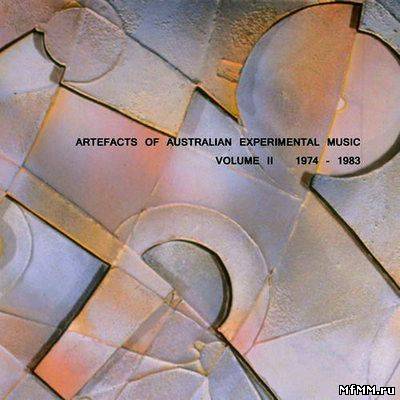The story of Australian experimental music continues with Artefacts Volume II documenting the explosion of Australian experimental music practice from the mid 1970s; from the use of synthesisers and computers, through to the radical fringes of post-punk, and to the beginnings of industrial and dark wave. This double CD set complete with 16 page booklet features one of Warren Burt’s first compositions completed in Australia, the Loop Orchestra’s first performance, South Australian industrial noise/punk cabaret, Melbourne post-punk minimalism, mid-1970s Brisbane Dadaist noise/audio collage, early Sydney aleatoric electronica, and much more.
Where Clinton Green’s task compiling the first disc in the Artefacts series was similar to that of an archaeologist or conservator, for Artefacts II, an editor’s steely vision was no doubt a necessary accoutrement; “the task of compiling this CD has been one of deciding which artists to choose from a much larger selection”. Artefacts II comes across like the belligerent older brother of the NMA tapes series (rereleased by Shame File in 2006) and Chapter Music’s Can’t Stop It! compilations, albeit an older brother who is listening to Cage and The Cramps whilst reading Camus.
The work of avant-garde composer Ron Nagorcka brings a feeling of continuity between Volumes I and II. ‘Apathetic Anomaly’ from 1973 concluded Volume I, whereupon Nagorcka moved to San Diego to undertake postgraduate studies. Whilst there, he struck up a friendship with Warren Burt, and they both returned in 1975, and were instrumental in setting up the Clifton Hill Community Music Centre the following year.
Starting proceedings out on Volume II is one of Burt’s first Australian compositions. ‘Nighthawk, part 3 Bittern’ features mysterious pitch-bent gongs, urban field recordings and squeaky toys complimenting Burt’s circular syntax, sourced from cut-up Melbourne newspapers. An excerpt from Nagorcka’s ‘Atom Bomb’ performed in 1977at the CHCMC, brings together the two composers for a polemic soaked plinkity-plonk drone fest. Moving Northwards, we hear The Loop Orchestra’s first recording aired on Sydney’s 2MBS FM in 1982, all hypnotic musique concrete loops and echoes of contemporary tape manipulation from European industrialists like Coil and Brume. One can only imagine what bafflement would have emanated from the staid Mahler enthusiasts of the North Shore when this aired.
Looped tapes are the predominant source material of the first four tracks, but synths and electronics soon take over. The ever-fetishable EMS VCS-3 and Synthi 100 features heavily on Ros Bandt’s I-Ching derived kosmiche trip, ‘Dr Who’ composer Tristram Cary, Carl Vine, and Paul Turner. Turner’s ‘Panels V’ contains curious synth stylings that caress and itch their way into looped vocals seemingly sourced from a soft furnishings radio talkback show!
A darker muse inhabits the posterior of Disc I – chugging synthesizers and loops collide with a distinctly industrial hue on Browning Mummery’s ‘Do the Eyes of the Dead Retain Pictures’. Severed Heads’ ‘Dance’ from 1980 hits the listener around the head with queasy and insistent electroid groove. Ian Hartley’s ‘Train Je Taime’ merges motorik body music and ululations of a seemingly erotic nature together.
The start of Disc II is more band-driven; with the stately minimalist naivety of Essendon Airport. Philip Brophy’s Tsk Tsk Tsk sound like The Muppet Band and Faust juiced up and jamming at the CHCMC; Brophy’s Disco-not-Disco project Asphixiation would have been a more interesting inclusion. You’ll probably not want to listen to Adelaide’s Purple Vulture Shit’s ‘Do a Shit’ more than once, this blend of Pussy Galore, Poison Dwarfs and The Vaselines in a bar-room brawl is cabaret scatology at its lowest. Eminently more fascinating is PVS member Justin Butler’s (Justinstinkt) blend of DIY tape manipulation found towards the end of Disc II.
Ad Hoc moves Disc II away from abrasive Post-punk gestures and into a beguilingly introspective minimalism that urges further exploration, hinting obliquely towards the current hypnogogic sounds of 2010. This Melbourne improvisational trio featured David Wadelton, Chris Knowles (who worked together in Signals, also included on Disc II) and James Clayden, to these ears this track is the discovery of this compilation – I can only hope that Shame File might be able to re-release the Distance cassette that this piece is sourced from, in its entirety.
An irreverent improvised strain with a devilish sense of the absurd rears its head midway through Disc II, Rik Rue/Jon Rose/Peter Kelly and Jon Rose/Tony Hobbs bounce through enough movements, tropes and ideas to make even a jaded The Wire journo jump. Environmental Recordings and dronal anarchy bring Artefacts II to a conclusion, showcasing a contemplative strain of the avant-garde that remains prevalent in Australia to this day. On the Genoa River, Les Gilbert and friend heft fire-blackened stones into the depths, punctuating the near silence, whilst a boiler-suited Sarah Hopkins makes her Harmonic Whirlies squeal with eerie delight.
Thanks to Clinton Green and other such enthusiastic music lovers, the unheralded and obscured audio palimpsests of Australia’s recent past are available at for a new generation of listeners to grapple with. European aficionados have long clamoured after Australian post-punk and avant-garde music, can it now find its way to a local audience that for the most part were too young to participate in, or even be exposed to. If Artefacts II brings about more questions than it answers, that can only be a good thing.







 Музыка не может мыслить, но она может воплощать мысль.
Музыка не может мыслить, но она может воплощать мысль.